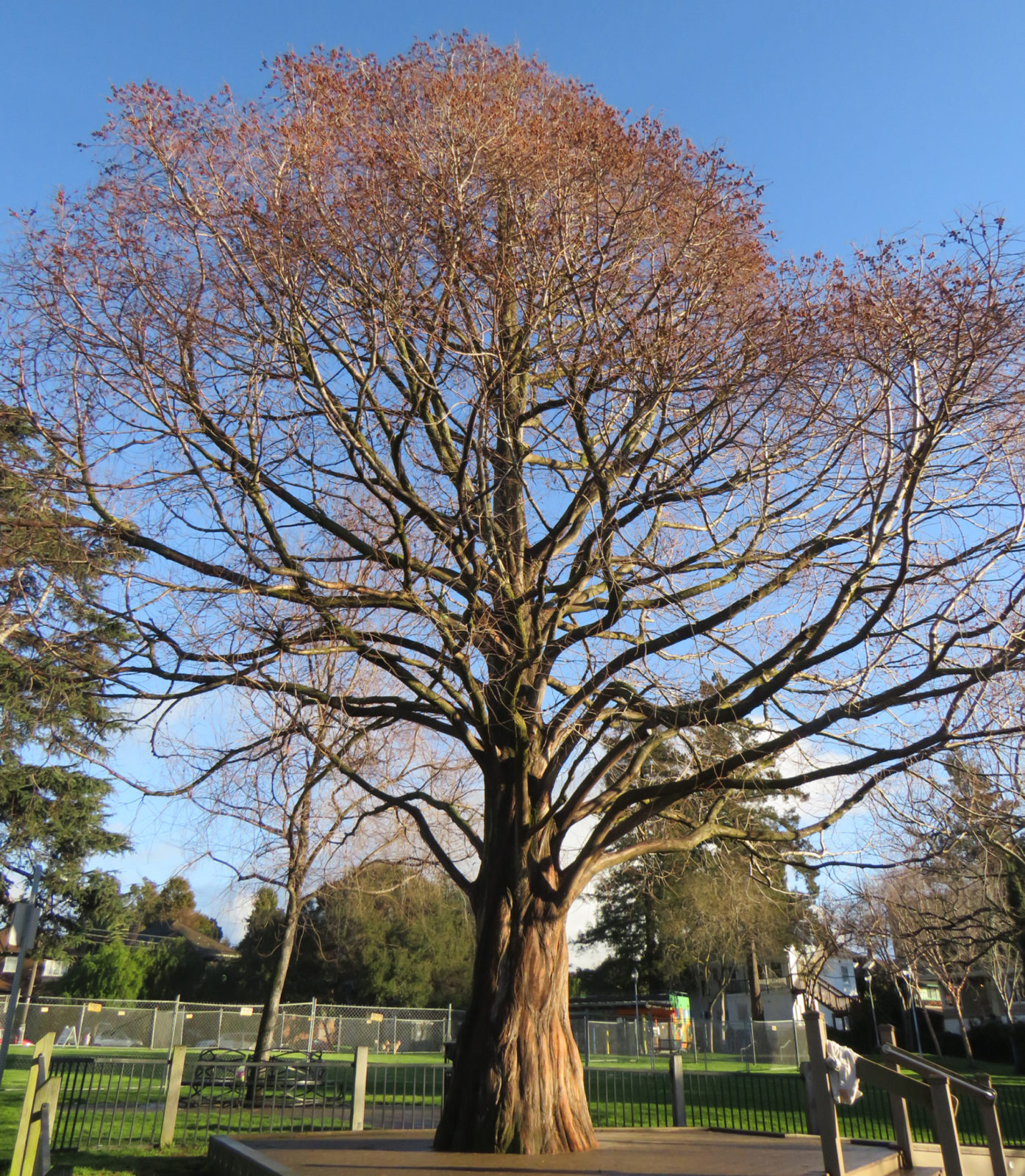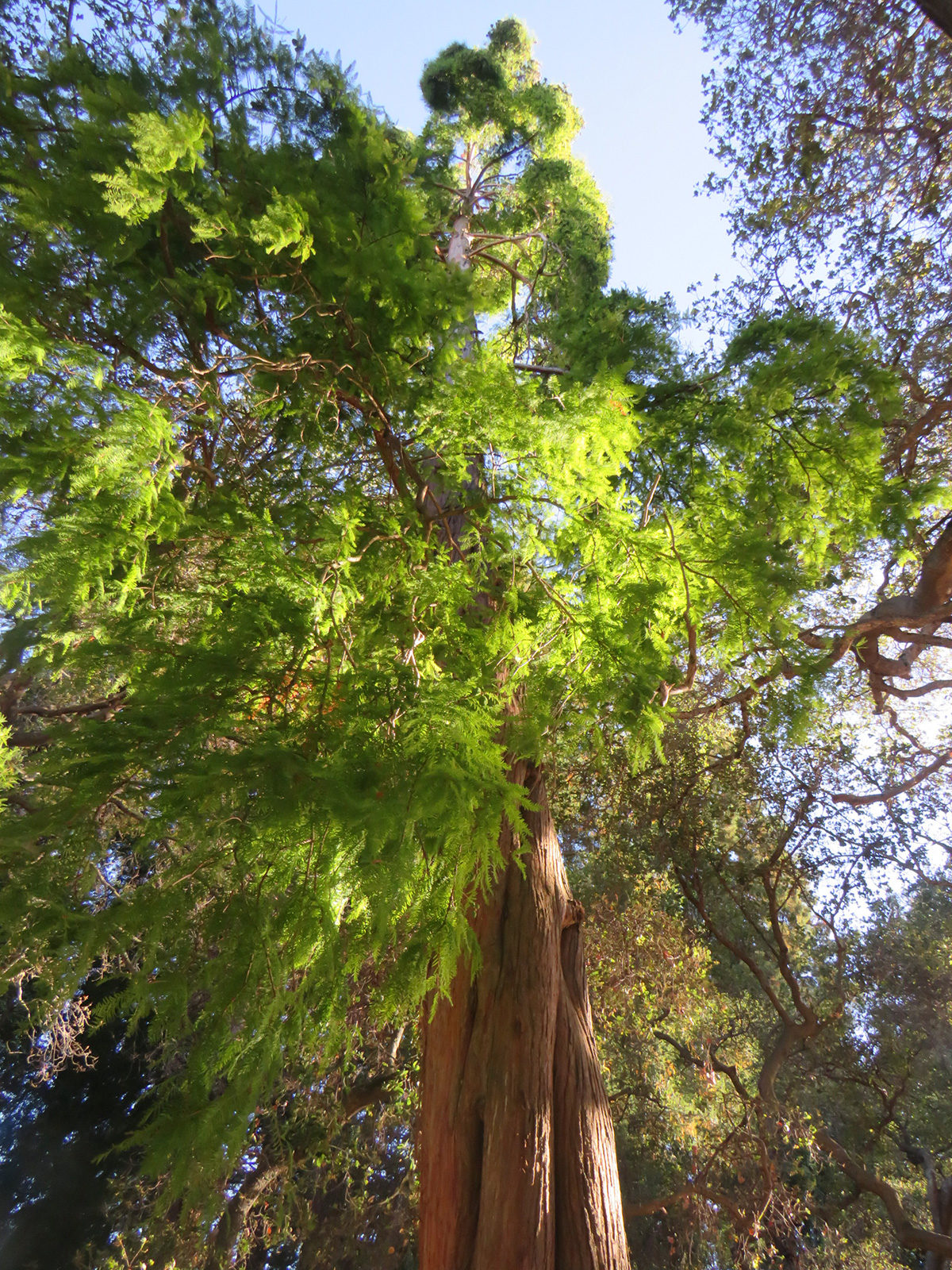
I sit under the redwoods of South Berkeley’s Willard Park to find peace and relief from a deadly pandemic and a divided nation. I am in good company. Redwoods have united nations. In 1945, 500 delegates representing 46 nations gathered under the redwoods at Muir Woods National Monument to mourn the death of President Franklin Delano Roosevelt. These days though I find it’s not the familiar coast redwoods but the bare winter silhouette of the dawn redwood (Metasequoia glyptostroboides), also called the dinosaur tree, that catches my attention.
With its wide, outstretched branches, it looks like a protective guardian in the center of the children’s playground at Willard Park. This deciduous conifer is understated compared to its massive family members—the coast redwood (Sequoia sempervirens) and the giant sequoia (Sequoiadendron giganteum). The dawn redwood grows an average of 50-60 feet, but can reach heights above 150 feet, and live for hundreds of years. Its distinctive red bark contrasts with its feathery lime-green needles, which unlike the coast redwoods and sequoias, change color to turn burnt orange in the fall. Despite its smaller stature, it is a true survivor, thought by scientists to be extinct until the 1940s. Though it doesn’t grow wild in California, the dawn redwood enlivens parks throughout the Bay Area, largely due to the efforts of the late UC Berkeley paleontologist Ralph Chaney.

In 1941, Japanese paleobotanist Shigeru Miki ignited the dawn redwood’s scientific discovery. Miki wrote an article about fossils resembling sequoias that evolved 100 million years ago. He named them metasequoias—meaning “like sequoias.” These trees had been around when dinosaurs ruled. They had an extensive range and grew in Asia, North America, and Greenland. As far as Miki knew they were extinct. But two years later, forester Wang Zhan came across an unusual tree in the Sichuan Province in south-central China and collected a branchlet and two cones from it. The tree specimens passed through several hands before reaching forestry professor W.C. Cheng at the National Central University in Zhongjing. Cheng couldn’t identify the tree, but he sent his assistants to collect flowers and young fruits, which eventually reached Hsen Hsu Hu of the Fan Memorial Institute of Biology in Beijing.
Hu happened to have just read Miki’s tree fossil article as he studied the tree specimens Cheng had sent him. Then, it hit him—these were dawn redwoods. They were not extinct, but alive! Hu wrote letters to two American colleagues, Elmer D. Merrill of Harvard and Ralph Chaney of UC Berkeley, and enclosed a packet of dawn redwood seeds. When Chaney received the letter and the seeds, he resolved to go to China and see the trees for himself. San Francisco Chronicle science writer Milton Silverman, who was in Chaney’s office at the time, was determined to accompany him. He convinced the Chronicle to let him cover the trip.
In 1948, Chaney, Silverman, and others embarked on an adventure to find the dawn redwoods in China’s remote interior. During the journey, they hiked over treacherous terrain, survived a bandit attack, and braved frigid weather. After three grueling days, the group arrived in the Sichuan Province in south-central China. To their amazement they saw about 1,000 dawn redwoods surrounded by chestnuts, oaks, beech, and birch trees.
Chaney wrote: “We stood beneath the great tree, our hands upon its gray, red-flecked bark, our eyes uplifted to branches which rose nearly a hundred feet above. Here was a fossil come to life, a giant whose kind had persisted out of the past to tell us the story of the earth millions of years before man came to live on it.”
Chaney and Silverman thought they could get the seedlings back home safely. However, when a Honolulu customs agent saw the seedlings, he threatened to seize and incinerate them. Chaney argued with the agent that these seedlings were millions of years old. When the agent determined the seedlings were over 150 years old and qualified as antiques, he let Chaney and the seedlings through customs.
After returning home, Silverman and the Chronicle’s editorial staff coined the term “dawn redwoods” to capture readers’ attention. It stuck.

The International Union for the Conservation of Nature lists dawn redwoods as endangered where they grow naturally in China. In 1949, on a trip to Tokyo, Chaney gave five dawn redwood seedlings to Emperor Hirohito of Japan. Dawn redwoods still grow in Japanese parks today, and throughout the world. A redwood grove and a plaque at the Humboldt Redwoods State Park memorializes Ralph Chaney’s accomplishments on the 2.4 mile Chaney-Drury trail. Thanks to Chaney, and others, there is no shortage of dawn redwoods in the Bay Area. Like friendly neighbors, they are part of the community and can be seen at:




